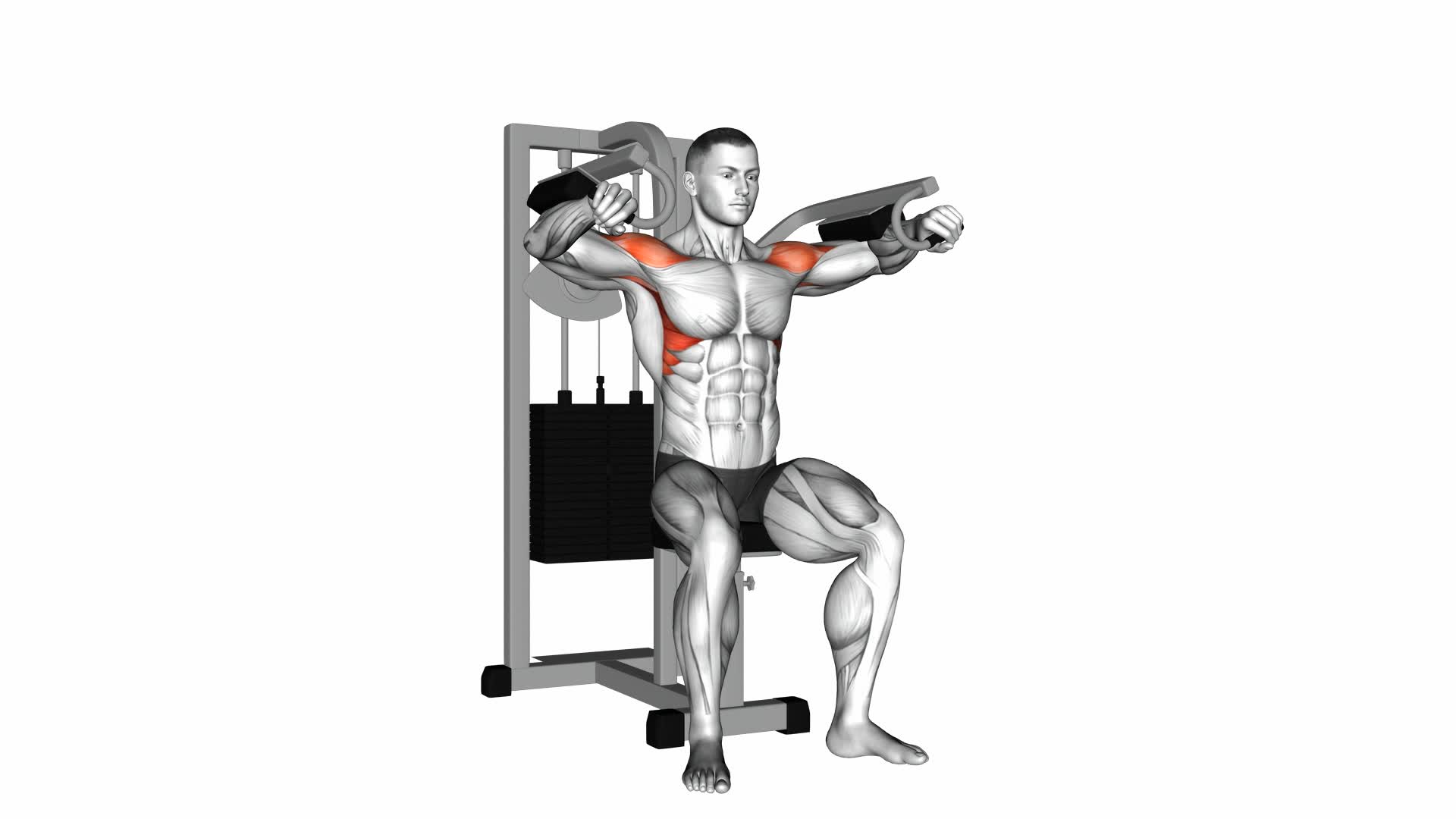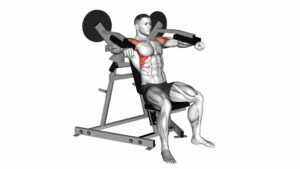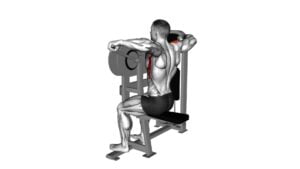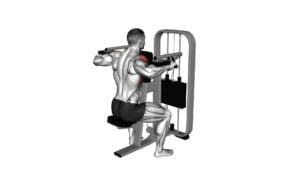Lever Lateral Raise – Video Exercise Guide & Tips

Discover the benefits of the lever lateral raise in this informative video exercise guide.
Watch This Exercise Video
Learn how to properly perform this exercise and avoid common mistakes.
Increase the intensity of your workouts with tips and techniques to maximize results.
Watch the video and get started on your fitness journey today!
Key Takeaways
- The lever lateral raise targets the lateral deltoids and strengthens and tones shoulder muscles.
- It improves shoulder stability and increases overall shoulder strength.
- The exercise can enhance the appearance of the shoulders and create definition and sculpted muscles.
- Variations and customization of the lever lateral raise allow for targeting different parts of the deltoids, challenging muscles, and customizing the workout to individual fitness levels and goals.
Benefits of the Lever Lateral Raise
You will experience several benefits when performing the Lever Lateral Raise exercise. This exercise primarily targets your lateral deltoids, which are the muscles on the sides of your shoulders. One of the main benefits of the Lever Lateral Raise is that it helps to strengthen and tone these muscles, giving your shoulders a more defined and sculpted appearance. Additionally, this exercise can improve your shoulder stability and increase your overall shoulder strength, which can be beneficial in various daily activities and sports.
Another benefit of the Lever Lateral Raise is that it allows for variations to target different areas of your shoulders. For example, you can perform this exercise with your arms straight or slightly bent, which will change the emphasis on different parts of your deltoids. Additionally, you can adjust the weight and resistance to suit your fitness level and goals. By incorporating variations into your routine, you can continue to challenge your muscles and avoid plateaus.
Equipment Needed for the Lever Lateral Raise
To perform the Lever Lateral Raise, you'll need essential equipment such as a lever machine or a cable machine with adjustable pulleys. These machines provide the necessary resistance and stability for the exercise.
If you don't have access to a lever machine, you can use dumbbells as an alternative.
Essential Equipment for Raise
To perform the Lever Lateral Raise, you'll need specific equipment. The essential equipment for this exercise includes dumbbells or resistance bands.
Dumbbells are recommended for beginners, while resistance bands provide a great alternative for those who prefer a lighter resistance or need a modification due to injury. Both options allow you to increase or decrease the resistance based on your fitness level.
It's important to choose the appropriate weight or resistance that challenges you without compromising your form. Additionally, a mat or a stable surface is recommended for comfort and stability during the exercise.
Alternatives to Lever
For the Lever Lateral Raise, if you don't have access to a lever, there are alternative equipment options you can use.
One option is dumbbells. Holding a dumbbell in each hand, you can perform lateral raises by raising your arms out to the sides until they're parallel to the floor.
Another option is resistance bands. Secure the resistance band under your feet and hold the ends in each hand. With your arms by your sides, raise them out to the sides until they're parallel to the floor.
You can also try using a cable machine. Attach a handle to the cable and stand with your side facing the machine. Raise your arm out to the side against the resistance of the cable.
These lateral raise variations provide effective shoulder exercise alternatives to the lever.
Proper Form and Technique for the Lever Lateral Raise
Maintain a strong and stable core while performing the Lever Lateral Raise to effectively target and strengthen your lateral deltoids.
This exercise has several benefits, including improving shoulder stability, increasing shoulder muscle strength, and developing better posture.
To properly execute the Lever Lateral Raise, begin by sitting on the machine with your back against the backrest and your feet flat on the floor. Grasp the handles with a neutral grip and keep your elbows slightly bent.
Engage your core and lift the handles out to the sides, maintaining a controlled and smooth motion. Make sure to avoid using momentum or swinging your body during the movement.
Control the weight as you lower it back down and repeat for the desired number of repetitions.
To add variation to your workout, you can try performing the Lever Lateral Raise with one arm at a time or using different grips.
Remember to always start with a weight that challenges you but allows you to maintain proper form throughout the exercise.
Common Mistakes to Avoid During the Lever Lateral Raise
To ensure proper execution of the Lever Lateral Raise, there are a few common mistakes you should avoid.
First, be mindful of your arm positioning – keep your elbows slightly bent and maintain a slight forward lean at the waist.
Secondly, pay attention to your form and avoid swinging your body or using momentum to lift the weight.
Lastly, don't overload the weight – start with a manageable weight and gradually increase as your strength improves.
Incorrect Arm Positioning
When performing the lever lateral raise, it's important to ensure that your arms are positioned correctly to avoid common mistakes.
One common mistake is having incorrect arm positioning, which can hinder the effectiveness of the exercise and potentially lead to injury. To avoid this mistake, make sure that your arms are straight and parallel to the ground throughout the movement. Avoid bending your elbows or allowing your wrists to drop.
Keeping your arms in the correct position will allow for proper activation of the lateral deltoids and prevent unnecessary strain on other muscles.
Remember to maintain proper form and alignment to maximize the benefits of the lever lateral raise and minimize the risk of injury.
Lack of Proper Form
Avoid making common mistakes and ensure proper form during the lever lateral raise by keeping your arms straight and parallel to the ground. One of the most common errors in this exercise is allowing your arms to bend or drop below shoulder level. This not only reduces the effectiveness of the exercise but also puts unnecessary strain on your shoulder joints.
To maintain proper technique, focus on engaging your shoulder muscles and keeping your elbows slightly bent throughout the movement. Another mistake to avoid is using momentum to lift the weights. Remember to control the movement and avoid swinging your body.
Overloading the Weight
Make sure you don't overload the weight during the lever lateral raise, as it can lead to ineffective results and potential injury. Overloading refers to using a weight that's too heavy for your current strength level or attempting to increase the weight too quickly.
Proper technique is crucial for maximizing the benefits of this exercise and avoiding unnecessary strain on your muscles and joints. Instead of focusing on lifting heavy weights, prioritize the quality of your movements and maintain control throughout the exercise.
It's important to remember that progressive overload, which involves gradually increasing the weight over time, is the key to building strength and muscle. By gradually increasing the weight and maintaining proper form, you can effectively challenge your muscles and achieve better results.
Now, let's move on to some tips to increase the intensity of the lever lateral raise.
Tips to Increase the Intensity of the Lever Lateral Raise
To maximize the effectiveness of your lever lateral raise, focus on increasing the intensity by gradually adding resistance over time. This will help you increase shoulder strength and improve overall shoulder mobility.
One way to add resistance is by using a heavier weight or resistance band. Start with a weight or band that challenges you but still allows you to maintain proper form. As you become comfortable with the exercise, gradually increase the weight or tension of the band.
Another method to increase intensity is by performing the exercise at a slower pace. This will engage your muscles for a longer period of time, leading to increased muscle activation and growth.
Additionally, you can incorporate drop sets into your lever lateral raise routine. Start with a heavier weight and perform as many repetitions as you can. Then, immediately switch to a lighter weight and continue the exercise until you reach muscle fatigue.
Sample Workout Routine Incorporating the Lever Lateral Raise
To maximize the benefits of the lever lateral raise, incorporate it into your comprehensive shoulder workout routine. This exercise targets the deltoid muscles, specifically the lateral deltoids, which are responsible for shoulder abduction and stabilization. By adding the lever lateral raise to your routine, you can effectively strengthen and tone these muscles.
There are several workout variations you can incorporate to challenge and stimulate your muscles in different ways. One option is to perform the lever lateral raise in a superset with another shoulder exercise, such as the overhead press or front raise. This will help increase the overall intensity of your workout and provide a well-rounded shoulder routine.
Another variation is to perform the lever lateral raise with different grip positions. Switching between a pronated grip (palms facing down) and a neutral grip (palms facing each other) can target different areas of the deltoids and add variety to your workout.
To ensure proper form and avoid injury, start with lighter weights and gradually increase the resistance as you become more comfortable with the exercise. Remember to maintain a slight bend in your elbows and engage your core for stability throughout the movement.
Incorporating the lever lateral raise into your shoulder workout routine can help you achieve stronger and more defined shoulders. Experiment with different variations to keep your workouts challenging and effective.
Frequently Asked Questions
What Are Some Alternative Exercises That Target the Same Muscle Groups as the Lever Lateral Raise?
If you're looking for alternative exercises that target the same muscle groups as the lever lateral raise, there are a few options you can try.
Some popular alternatives include:
- Dumbbell lateral raises
- Cable lateral raises
- Bent-over lateral raises
These exercises work the same muscles as the lever lateral raise, but with slight variations in movement and equipment.
Keep in mind that if you have shoulder injuries, it's important to modify these exercises accordingly to avoid further discomfort or injury.
Can the Lever Lateral Raise Be Modified for Individuals With Shoulder Injuries or Limitations?
If you have a shoulder injury or limitations, you may wonder if the lever lateral raise can be modified to suit your needs.
The lever lateral raise is a shoulder exercise that targets the deltoid muscles.
However, if you have shoulder issues, it's important to consult with a healthcare professional or a certified trainer who can provide appropriate modifications.
They can help you find alternative exercises or adjustments to the lever lateral raise that won't aggravate your condition.
How Frequently Should the Lever Lateral Raise Be Performed in a Workout Routine?
To maximize the benefits of lever lateral raises in your shoulder workout routine, it's important to consider frequency. How often should you perform this exercise?
Well, the frequency will depend on your fitness level and goals. Generally, incorporating lever lateral raises 2-3 times per week is a good starting point. As you progress, you can gradually increase the frequency to challenge your shoulder muscles even more.
Remember to listen to your body and give yourself enough rest between sessions for optimal recovery.
Are There Any Specific Warm-Up Exercises Recommended Before Performing the Lever Lateral Raise?
Before performing the lever lateral raise, it's important to do specific warm-up exercises. These exercises help to prepare your muscles and joints for the movement and reduce the risk of injury. They can include shoulder rotations, arm circles, and light weight shoulder presses.
The lever lateral raise is a great exercise for targeting the lateral deltoids and improving shoulder strength and stability. It also helps to enhance overall shoulder definition and can be incorporated into your upper body workout routine for optimal results.
Can the Lever Lateral Raise Be Incorporated Into a Full-Body Workout Routine, or Is It More Effective When Focused on Shoulder Training Only?
Incorporating the lever lateral raise into a full-body workout routine is entirely up to you. While it's an effective exercise for shoulder training, it can also be a valuable addition to a comprehensive workout plan. By targeting the shoulders, the lever lateral raise helps build strength and definition in that area.
However, it's important to consider your overall fitness goals and balance your workouts accordingly. Remember to consult with a fitness professional to determine the best approach for your specific needs.
Conclusion
In conclusion, the lever lateral raise is a highly effective exercise for targeting and strengthening the shoulders. By following proper form and technique, you can maximize the benefits of this exercise while minimizing the risk of injury.
Remember to avoid common mistakes and consider incorporating the lever lateral raise into your workout routine for improved shoulder strength and stability.
With the right equipment and intensity, you can achieve great results with this exercise.

Author
Years ago, the spark of my life’s passion ignited in my mind the moment I stepped into the local gym for the first time. The inaugural bead of perspiration, the initial endeavor, the very first surge of endorphins, and a sense of pride that washed over me post-workout marked the beginning of my deep-seated interest in strength sports, fitness, and sports nutrition. This very curiosity blossomed rapidly into a profound fascination, propelling me to earn a Master’s degree in Physical Education from the Academy of Physical Education in Krakow, followed by a Sports Manager diploma from the Jagiellonian University. My journey of growth led me to gain more specialized qualifications, such as being a certified personal trainer with a focus on sports dietetics, a lifeguard, and an instructor for wellness and corrective gymnastics. Theoretical knowledge paired seamlessly with practical experience, reinforcing my belief that the transformation of individuals under my guidance was also a reflection of my personal growth. This belief holds true even today. Each day, I strive to push the boundaries and explore new realms. These realms gently elevate me to greater heights. The unique combination of passion for my field and the continuous quest for growth fuels my drive to break new ground.







